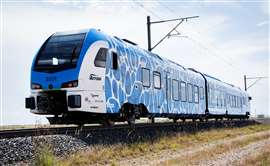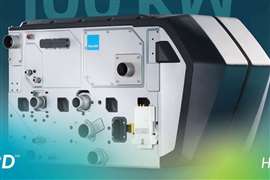California’s hydrogen fuel cell-powered commuter train to enter service soon
October 07, 2024
 The Stadler FLIRT H2 passenger train, which is going into service in San Bernardino, Calif., under the moniker of ZEMU (Zero-Emission Multiple Unit). (Photo: Stadler)
The Stadler FLIRT H2 passenger train, which is going into service in San Bernardino, Calif., under the moniker of ZEMU (Zero-Emission Multiple Unit). (Photo: Stadler)
In late June, the San Bernardino County Transportation Authority (SBCTA) in Southern California announced the arrival at the San Bernardino Depot Train Station of North America’s first self-powered, zero-emission passenger train that will meet Federal Railroad Administration (FRA) regulations. Called a Zero Emission Multiple Unit (ZEMU), the passenger train is powered by a hydrogen fuel cell, which only generates emissions of water vapor.
SBCTA said the train is expected to operate between the cities of San Bernardino and Redlands as part of the Metrolink commuter rail system. The cities are connected as part of Metrolink’s Arrow Corridor. The distance between the stations that are farthest apart is approximately 22 mi.
SBCTA said the ZEMU’s arrival in Southern California was the result of more than 10 years of planning, including four years of train development. The agency, which said it serves one of the fastest-growing economic and population centers in the country as well as one of the more challenged air quality basins in North America, saw the need for efficient, sustainable passenger rail as part of the regional transportation ecosystem.
“ZEMU’s arrival in San Bernardino is a significant milestone recognizing years of strategic planning for a greener rail system and a commitment to innovative transportation solutions in San Bernardino County,” said SBCTA President Ray Marquez in a press release.
The ZEMU was manufactured by Swiss train maker Stadler, which refers to the model as the Fast Light Intercity and Regional Train (FLIRT) H2.
SBCTA said the agency received federal funding in 2016 to help build the infrastructure that supports the Arrow service along the San Bernardino line. In 2019, Stadler signed the contract with SBCTA to deliver the FLIRT H2 to the agency.
According to Stadler’s website, the FLIRT H2 is intended to replace diesel trains on lines that are either nonelectrified or partially electrified. The single-decker train offers a lightweight aluminum carbody and can be manufactured in two- or four-car varieties. The ZEMU has two cars with the train’s hydrogen fuel tank and battery propulsion system situated between them.
Stadler data said the ZEMU has a maximum range of approx. 286 mi. (460km) at a top speed of 79 mph (127 km/h). The train has 116 seats and can be refueled in under 30 minutes.
In March, Stadler announced that the Flirt H2 achieved a world record as the fuel cell electric, multiple unit passenger train traveling the longest distance without refueling or recharging. The record-setting distance was 1,741.7 mi. (2,803 km) — a trip that Stadler said took over 46 hours. The record attempt was conducted at technology company ENSCO’s test center in Pueblo, Colo. Stadler said the record has been recorded by Guiness World Records and joins a record Stadler holds for the longest journey for a battery-powered passenger train, which was achieved with its battery-powered FLIRT model.
SBCTA said that in the coming weeks, ZEMU will begin running test routes on Metrolink’s Arrow Corridor along the San Bernardino Line with a goal of safe entry into service in 2025.
MAGAZINE
NEWSLETTER

CONNECT WITH THE TEAM











